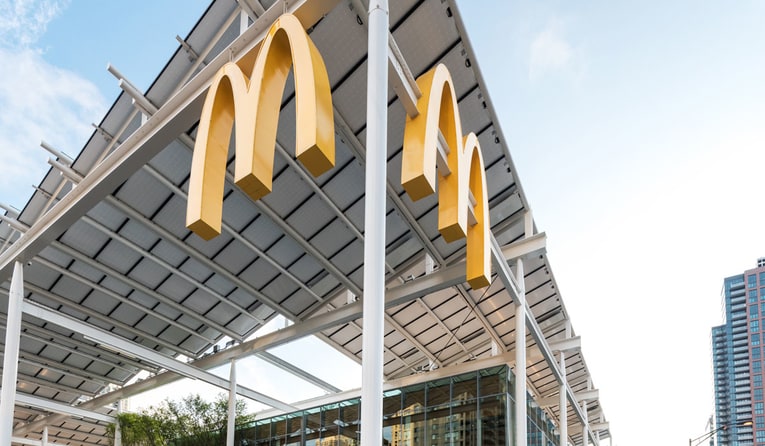
Once the hallmark of countless pre-teen birthday parties and bar mitzvahs, late night weekend eats and tourist-fueled lunches, the Rock ‘n’ Roll theme showcased by McDonald’s flagship store in downtown Chicago for the past 35 years has left the stage.
The massive renovation project, completed late last summer after an eight-month closure, was meant to represent the restaurant “experience of the future,” showcasing self-serve kiosks, table service and mobile order/payment and delivery in an environmentally-friendly setting, execs said in a statement.
One of a kind
“Chicago, soon to be the home of our new headquarters, is special to our brand and we are proud to partner with our local franchisee on this one-of-a-kind restaurant that takes the McDonald’s dining experience to a whole new level,” said McDonald’s US president Chris Kempczinski. “This re-imagined location reflects our global commitment to elevate the customer experience through more modern restaurant designs and conveniences and positively impact our local communities and planet.”
The project comes on the heels of a McDonald’s headquarters move from Chicago’s western suburbs to a newly built office building downtown.
As a LEED (Leadership in Energy and Environmental Design) project, the 19,000 sq ft space, designed by Chicago-based Design and developed by Chicago-based Ross Barney Architects and Landini Associates in Sydney, features various environmentally-friendly aspects, including a floating glass “garden” and other green spaces inside and on the rooftop as well as energy saving cooking and HVAC equipment, interior and exterior LED lighting and an on-site solar panel for renewable energy collection. Also outside, drought-resistant and native landscaping, including white birch trees, planted throughout the outdoor plaza and park area help minimize irrigation and storm water runoff.
 Inside, the light tinder wood and steel frame, customers are greeted by optional self-serve kiosks where they can customize their orders with greater ease. Those wanting to order from a traditional counter proceed through the narrow hall to the back where they’ll see upgraded digital menu boards. Along the left side of the space there is an enhanced McCafé area with its own, separate counter showcasing a wider array of coffee drinks and baked goods. Seating for the restaurant sits on the right side of the restaurant as well as outside. Communal tables with wireless charging stations offer seating for singles or groups. Natural light pours into the space thanks to floor-to-ceiling glass walls.
Inside, the light tinder wood and steel frame, customers are greeted by optional self-serve kiosks where they can customize their orders with greater ease. Those wanting to order from a traditional counter proceed through the narrow hall to the back where they’ll see upgraded digital menu boards. Along the left side of the space there is an enhanced McCafé area with its own, separate counter showcasing a wider array of coffee drinks and baked goods. Seating for the restaurant sits on the right side of the restaurant as well as outside. Communal tables with wireless charging stations offer seating for singles or groups. Natural light pours into the space thanks to floor-to-ceiling glass walls.
Table service
Throughout the dining area, so-called “guest experience leaders” offer limited table service, such as drink refills, extra napkins, bussing and other needs. Some staffers also roam the kiosk area, offering help as needed. Thanks to a $6bn investment, the chain says it plans to transform most of its freestanding restaurants with these upgraded designs and technologies by 2020.
Just in time for the New Year, McDonald’s redesign falls in the category of a continuing trend toward new technology, self-service and automation in restaurants, especially in quick-serve ones. Also in Chicago, Lettuce Entertain You’s Wow Bao concept recently introduced a staffless, kiosk-only ordering platform within the four walls of one of its location, and Shake Shack has done the same in New York City.
Experts at research firm Datassential’s Foodscapes conference last Fall, however, pointed to some of these technologies – and even robots in foodservice – as something diners will likely see more of in the future, but also presented studies that show many consumers still want that human touch. Operators that combine both, such as employing kiosks alongside regular staffers for both types of ordering services (as McDonald’s now does), will likely see the most success in the future, they noted.
Amelia Levin
